Tuxedo Air Expansion Financing: Bond Features and Coupon Rate
VerifiedAdded on 2023/03/21
|10
|2296
|73
Case Study
AI Summary
This case study examines Tuxedo Air's plan to finance its expansion through a $35 million bond issue. It delves into the various bond features under consideration, such as security, seniority, sinking funds, call provisions, deferred calls, Canada plus call provisions, positive and negative covenants, conversion features, and floating-rate coupons, analyzing their impact on the bond's coupon rate. The study evaluates the advantages and disadvantages of each feature, considering the current market conditions and the challenges faced by small to medium-sized organizations in securing funding through bond offerings. Ultimately, it recommends that Tuxedo Air prioritize bond features that ensure marketability to investors, such as security bonds with collateral, which offer lower coupon rates and short-term durations, or long-term bonds with call provisions to manage ongoing payments effectively. The analysis concludes that while bonds offer predictable loan repayments and potential tax benefits, Tuxedo Air must carefully weigh the risks and public perception to successfully leverage the bond market for its expansion project.

Running head: FINANCING TUXEDO AIR’S EXPANSION PLANS WITH A BOND ISSUE
Financing Tuxedo Air’s Expansion Plans with a Bond Issue
Name of the Student:
Name of the University:
Author’s Note:
Course ID:
Financing Tuxedo Air’s Expansion Plans with a Bond Issue
Name of the Student:
Name of the University:
Author’s Note:
Course ID:
Paraphrase This Document
Need a fresh take? Get an instant paraphrase of this document with our AI Paraphraser

1FINANCING TUXEDO AIR’S EXPANSION PLANS WITH A BOND ISSUE
Table of Contents
Introduction:....................................................................................................................................2
1. Definition of the problem:...........................................................................................................2
2. Alternative solutions to the problem:..........................................................................................3
3. Evaluation and comparison of alternative solutions:...................................................................3
4. Recommendation and justification of effective solution:............................................................5
Conclusion:......................................................................................................................................6
References:......................................................................................................................................8
Table of Contents
Introduction:....................................................................................................................................2
1. Definition of the problem:...........................................................................................................2
2. Alternative solutions to the problem:..........................................................................................3
3. Evaluation and comparison of alternative solutions:...................................................................3
4. Recommendation and justification of effective solution:............................................................5
Conclusion:......................................................................................................................................6
References:......................................................................................................................................8
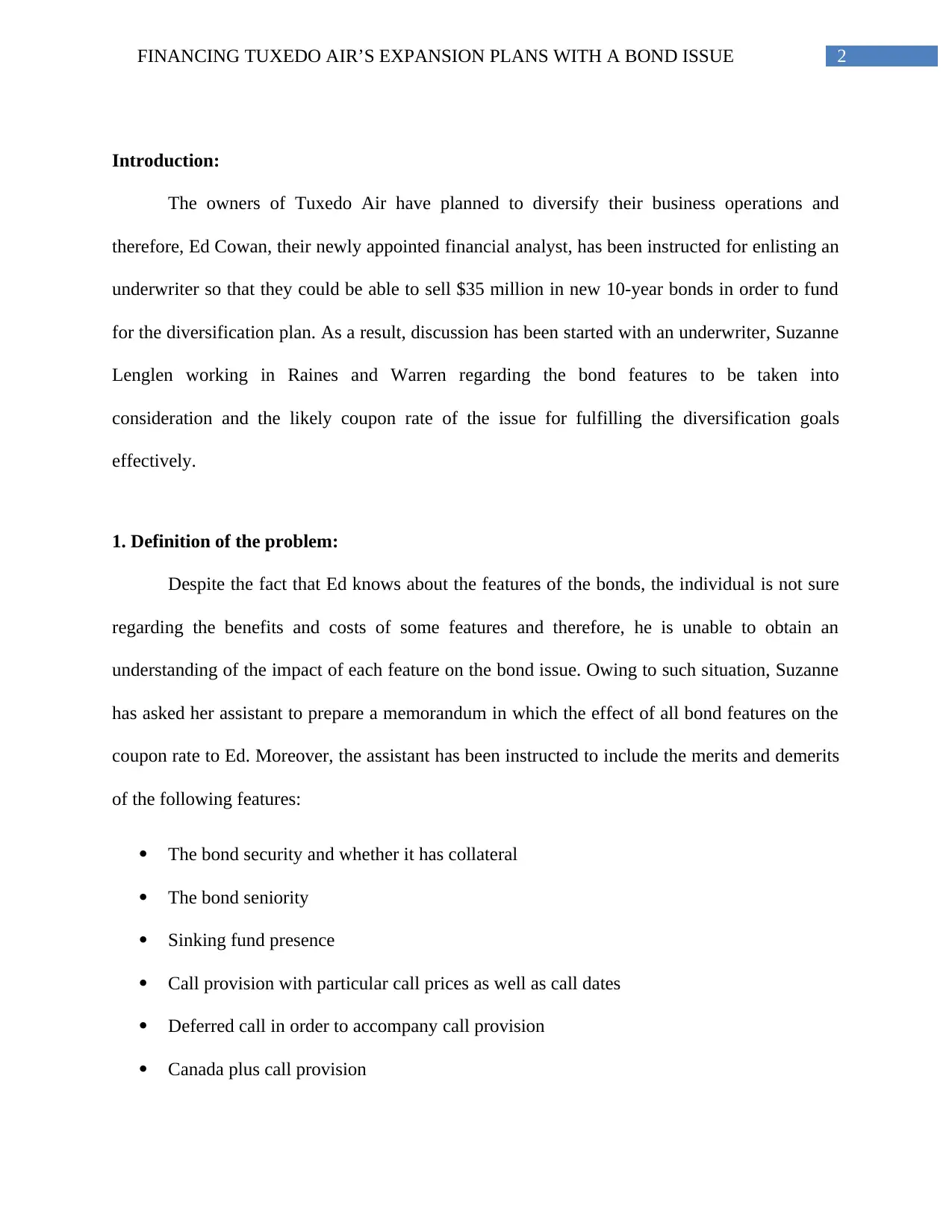
2FINANCING TUXEDO AIR’S EXPANSION PLANS WITH A BOND ISSUE
Introduction:
The owners of Tuxedo Air have planned to diversify their business operations and
therefore, Ed Cowan, their newly appointed financial analyst, has been instructed for enlisting an
underwriter so that they could be able to sell $35 million in new 10-year bonds in order to fund
for the diversification plan. As a result, discussion has been started with an underwriter, Suzanne
Lenglen working in Raines and Warren regarding the bond features to be taken into
consideration and the likely coupon rate of the issue for fulfilling the diversification goals
effectively.
1. Definition of the problem:
Despite the fact that Ed knows about the features of the bonds, the individual is not sure
regarding the benefits and costs of some features and therefore, he is unable to obtain an
understanding of the impact of each feature on the bond issue. Owing to such situation, Suzanne
has asked her assistant to prepare a memorandum in which the effect of all bond features on the
coupon rate to Ed. Moreover, the assistant has been instructed to include the merits and demerits
of the following features:
The bond security and whether it has collateral
The bond seniority
Sinking fund presence
Call provision with particular call prices as well as call dates
Deferred call in order to accompany call provision
Canada plus call provision
Introduction:
The owners of Tuxedo Air have planned to diversify their business operations and
therefore, Ed Cowan, their newly appointed financial analyst, has been instructed for enlisting an
underwriter so that they could be able to sell $35 million in new 10-year bonds in order to fund
for the diversification plan. As a result, discussion has been started with an underwriter, Suzanne
Lenglen working in Raines and Warren regarding the bond features to be taken into
consideration and the likely coupon rate of the issue for fulfilling the diversification goals
effectively.
1. Definition of the problem:
Despite the fact that Ed knows about the features of the bonds, the individual is not sure
regarding the benefits and costs of some features and therefore, he is unable to obtain an
understanding of the impact of each feature on the bond issue. Owing to such situation, Suzanne
has asked her assistant to prepare a memorandum in which the effect of all bond features on the
coupon rate to Ed. Moreover, the assistant has been instructed to include the merits and demerits
of the following features:
The bond security and whether it has collateral
The bond seniority
Sinking fund presence
Call provision with particular call prices as well as call dates
Deferred call in order to accompany call provision
Canada plus call provision
⊘ This is a preview!⊘
Do you want full access?
Subscribe today to unlock all pages.

Trusted by 1+ million students worldwide
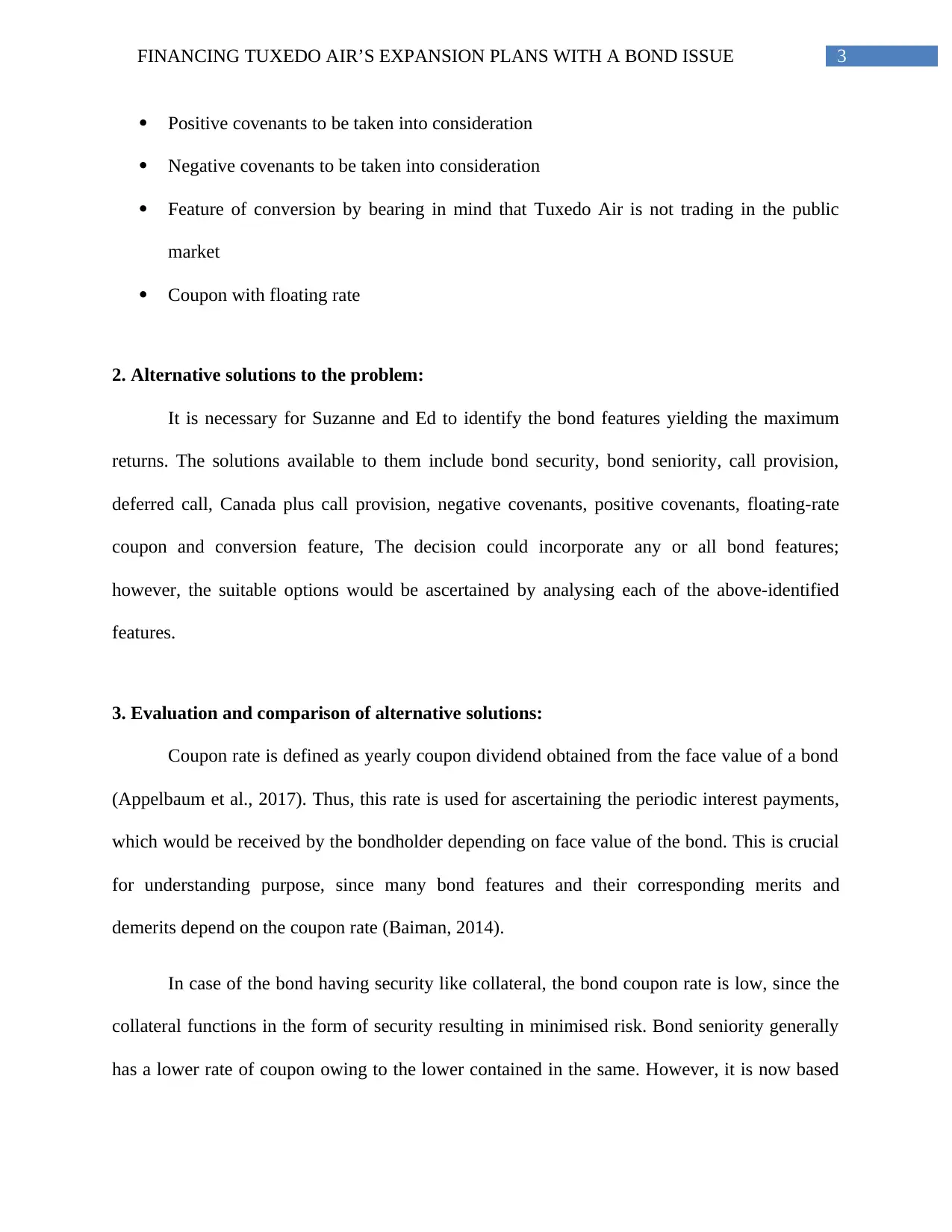
3FINANCING TUXEDO AIR’S EXPANSION PLANS WITH A BOND ISSUE
Positive covenants to be taken into consideration
Negative covenants to be taken into consideration
Feature of conversion by bearing in mind that Tuxedo Air is not trading in the public
market
Coupon with floating rate
2. Alternative solutions to the problem:
It is necessary for Suzanne and Ed to identify the bond features yielding the maximum
returns. The solutions available to them include bond security, bond seniority, call provision,
deferred call, Canada plus call provision, negative covenants, positive covenants, floating-rate
coupon and conversion feature, The decision could incorporate any or all bond features;
however, the suitable options would be ascertained by analysing each of the above-identified
features.
3. Evaluation and comparison of alternative solutions:
Coupon rate is defined as yearly coupon dividend obtained from the face value of a bond
(Appelbaum et al., 2017). Thus, this rate is used for ascertaining the periodic interest payments,
which would be received by the bondholder depending on face value of the bond. This is crucial
for understanding purpose, since many bond features and their corresponding merits and
demerits depend on the coupon rate (Baiman, 2014).
In case of the bond having security like collateral, the bond coupon rate is low, since the
collateral functions in the form of security resulting in minimised risk. Bond seniority generally
has a lower rate of coupon owing to the lower contained in the same. However, it is now based
Positive covenants to be taken into consideration
Negative covenants to be taken into consideration
Feature of conversion by bearing in mind that Tuxedo Air is not trading in the public
market
Coupon with floating rate
2. Alternative solutions to the problem:
It is necessary for Suzanne and Ed to identify the bond features yielding the maximum
returns. The solutions available to them include bond security, bond seniority, call provision,
deferred call, Canada plus call provision, negative covenants, positive covenants, floating-rate
coupon and conversion feature, The decision could incorporate any or all bond features;
however, the suitable options would be ascertained by analysing each of the above-identified
features.
3. Evaluation and comparison of alternative solutions:
Coupon rate is defined as yearly coupon dividend obtained from the face value of a bond
(Appelbaum et al., 2017). Thus, this rate is used for ascertaining the periodic interest payments,
which would be received by the bondholder depending on face value of the bond. This is crucial
for understanding purpose, since many bond features and their corresponding merits and
demerits depend on the coupon rate (Baiman, 2014).
In case of the bond having security like collateral, the bond coupon rate is low, since the
collateral functions in the form of security resulting in minimised risk. Bond seniority generally
has a lower rate of coupon owing to the lower contained in the same. However, it is now based
Paraphrase This Document
Need a fresh take? Get an instant paraphrase of this document with our AI Paraphraser

4FINANCING TUXEDO AIR’S EXPANSION PLANS WITH A BOND ISSUE
on minimised default threat (Butler & Ghosh, 2015). If the organisation defaults, the amount
would be recovered likely from the assets. In case of the presence of sinking fund, there would
be fall in the coupon rate. The reason is that it provides partial assurance to the bondholder,
which is advantageous for Tuxedo Air owing to the fact that it becomes more marketable. Any
provision associated with the particular price and call date would lead to rise in the coupon rate
(Danso & Adomako, 2014). However, call provision would be utilised only for benefitting the
organisation that would result in drawback for the bondholders.
In case of deferred call, the coupon rate would decline in relation to call provision having
deferred call. However, deferred call might result in business failure in calling the bonds during
the call protection period and as a result; the bondholders are protected during the same period
(Gitman, Juchau & Flanagan, 2015). In case of a Canada plus call provision, the coupon rates are
generally deemed to be lower. When there is call for such provision, the bondholders would
obtain the market price of the bond, which they could invest again in other bonds holding
identical features.
For any positive covenant, the coupon rate is mainly decreased. This type of covenant
assists in providing protection to the bondholders by compelling the organisation to take into
account different actions deemed to be advantageous for the bondholders (Mihăilă, 2014).
However, this covenant imposes certain restriction on the organisation at the time of taking any
action. In case of negative covenant, the coupon rate would be increased, since the organisation
would be benefitted by placing the bondholders at a drawback along with utilising increased
coupon rate in the form of leverage to the drawback (Narayanaswamy, 2017).
The bonds having conversion features generally have lower rates of coupon. Owing to the
presence of conversion feature, the bondholders are entitled to a number of benefits, since it is
on minimised default threat (Butler & Ghosh, 2015). If the organisation defaults, the amount
would be recovered likely from the assets. In case of the presence of sinking fund, there would
be fall in the coupon rate. The reason is that it provides partial assurance to the bondholder,
which is advantageous for Tuxedo Air owing to the fact that it becomes more marketable. Any
provision associated with the particular price and call date would lead to rise in the coupon rate
(Danso & Adomako, 2014). However, call provision would be utilised only for benefitting the
organisation that would result in drawback for the bondholders.
In case of deferred call, the coupon rate would decline in relation to call provision having
deferred call. However, deferred call might result in business failure in calling the bonds during
the call protection period and as a result; the bondholders are protected during the same period
(Gitman, Juchau & Flanagan, 2015). In case of a Canada plus call provision, the coupon rates are
generally deemed to be lower. When there is call for such provision, the bondholders would
obtain the market price of the bond, which they could invest again in other bonds holding
identical features.
For any positive covenant, the coupon rate is mainly decreased. This type of covenant
assists in providing protection to the bondholders by compelling the organisation to take into
account different actions deemed to be advantageous for the bondholders (Mihăilă, 2014).
However, this covenant imposes certain restriction on the organisation at the time of taking any
action. In case of negative covenant, the coupon rate would be increased, since the organisation
would be benefitted by placing the bondholders at a drawback along with utilising increased
coupon rate in the form of leverage to the drawback (Narayanaswamy, 2017).
The bonds having conversion features generally have lower rates of coupon. Owing to the
presence of conversion feature, the bondholders are entitled to a number of benefits, since it is
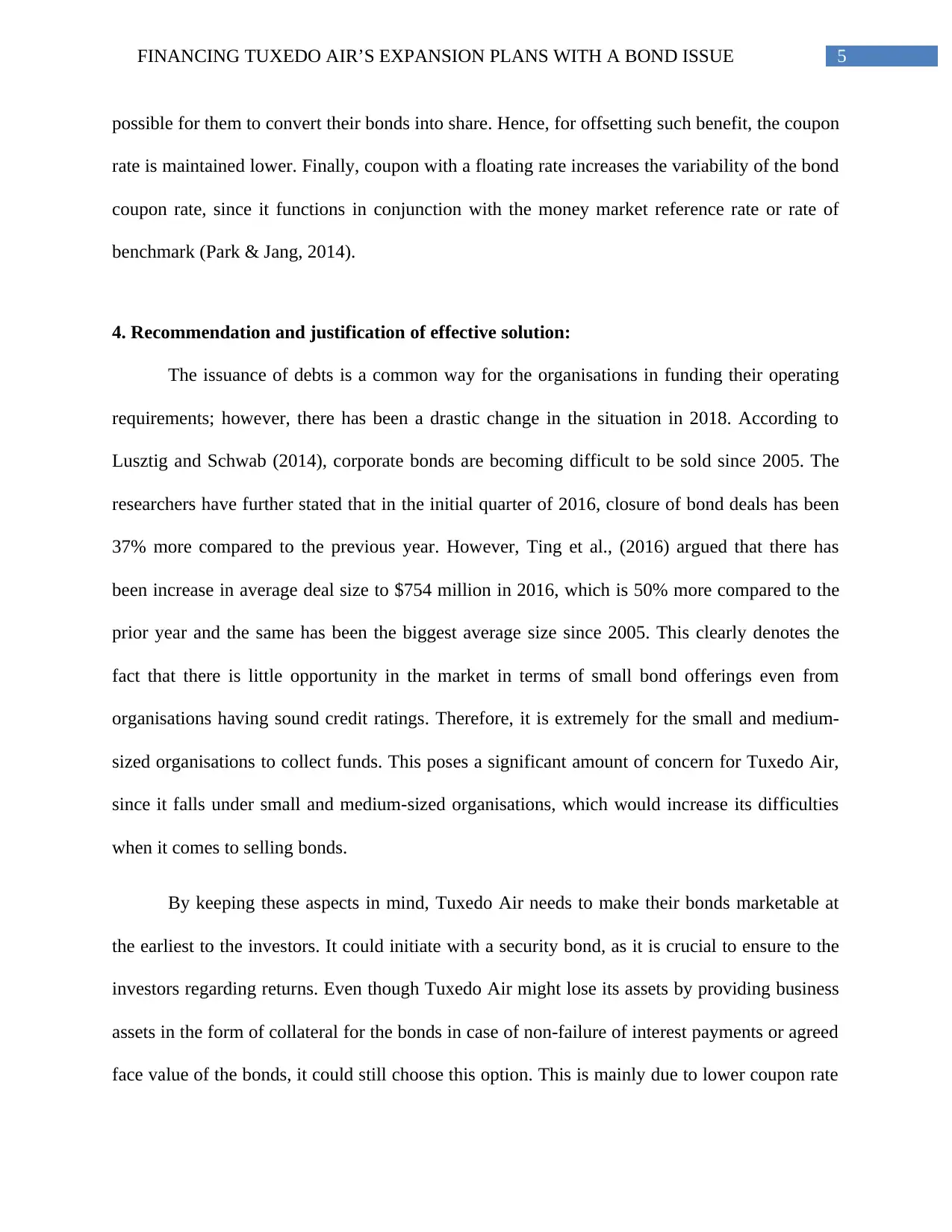
5FINANCING TUXEDO AIR’S EXPANSION PLANS WITH A BOND ISSUE
possible for them to convert their bonds into share. Hence, for offsetting such benefit, the coupon
rate is maintained lower. Finally, coupon with a floating rate increases the variability of the bond
coupon rate, since it functions in conjunction with the money market reference rate or rate of
benchmark (Park & Jang, 2014).
4. Recommendation and justification of effective solution:
The issuance of debts is a common way for the organisations in funding their operating
requirements; however, there has been a drastic change in the situation in 2018. According to
Lusztig and Schwab (2014), corporate bonds are becoming difficult to be sold since 2005. The
researchers have further stated that in the initial quarter of 2016, closure of bond deals has been
37% more compared to the previous year. However, Ting et al., (2016) argued that there has
been increase in average deal size to $754 million in 2016, which is 50% more compared to the
prior year and the same has been the biggest average size since 2005. This clearly denotes the
fact that there is little opportunity in the market in terms of small bond offerings even from
organisations having sound credit ratings. Therefore, it is extremely for the small and medium-
sized organisations to collect funds. This poses a significant amount of concern for Tuxedo Air,
since it falls under small and medium-sized organisations, which would increase its difficulties
when it comes to selling bonds.
By keeping these aspects in mind, Tuxedo Air needs to make their bonds marketable at
the earliest to the investors. It could initiate with a security bond, as it is crucial to ensure to the
investors regarding returns. Even though Tuxedo Air might lose its assets by providing business
assets in the form of collateral for the bonds in case of non-failure of interest payments or agreed
face value of the bonds, it could still choose this option. This is mainly due to lower coupon rate
possible for them to convert their bonds into share. Hence, for offsetting such benefit, the coupon
rate is maintained lower. Finally, coupon with a floating rate increases the variability of the bond
coupon rate, since it functions in conjunction with the money market reference rate or rate of
benchmark (Park & Jang, 2014).
4. Recommendation and justification of effective solution:
The issuance of debts is a common way for the organisations in funding their operating
requirements; however, there has been a drastic change in the situation in 2018. According to
Lusztig and Schwab (2014), corporate bonds are becoming difficult to be sold since 2005. The
researchers have further stated that in the initial quarter of 2016, closure of bond deals has been
37% more compared to the previous year. However, Ting et al., (2016) argued that there has
been increase in average deal size to $754 million in 2016, which is 50% more compared to the
prior year and the same has been the biggest average size since 2005. This clearly denotes the
fact that there is little opportunity in the market in terms of small bond offerings even from
organisations having sound credit ratings. Therefore, it is extremely for the small and medium-
sized organisations to collect funds. This poses a significant amount of concern for Tuxedo Air,
since it falls under small and medium-sized organisations, which would increase its difficulties
when it comes to selling bonds.
By keeping these aspects in mind, Tuxedo Air needs to make their bonds marketable at
the earliest to the investors. It could initiate with a security bond, as it is crucial to ensure to the
investors regarding returns. Even though Tuxedo Air might lose its assets by providing business
assets in the form of collateral for the bonds in case of non-failure of interest payments or agreed
face value of the bonds, it could still choose this option. This is mainly due to lower coupon rate
⊘ This is a preview!⊘
Do you want full access?
Subscribe today to unlock all pages.

Trusted by 1+ million students worldwide
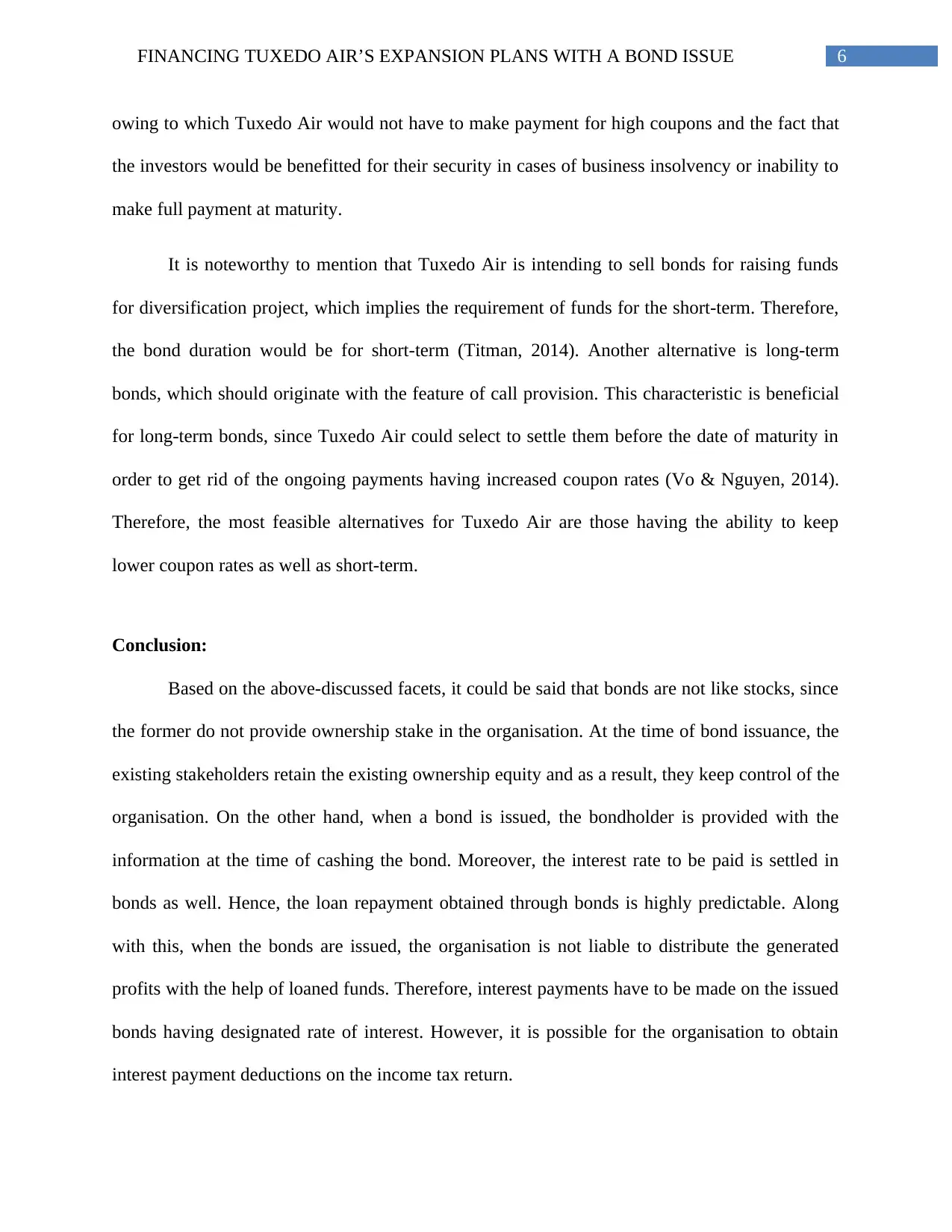
6FINANCING TUXEDO AIR’S EXPANSION PLANS WITH A BOND ISSUE
owing to which Tuxedo Air would not have to make payment for high coupons and the fact that
the investors would be benefitted for their security in cases of business insolvency or inability to
make full payment at maturity.
It is noteworthy to mention that Tuxedo Air is intending to sell bonds for raising funds
for diversification project, which implies the requirement of funds for the short-term. Therefore,
the bond duration would be for short-term (Titman, 2014). Another alternative is long-term
bonds, which should originate with the feature of call provision. This characteristic is beneficial
for long-term bonds, since Tuxedo Air could select to settle them before the date of maturity in
order to get rid of the ongoing payments having increased coupon rates (Vo & Nguyen, 2014).
Therefore, the most feasible alternatives for Tuxedo Air are those having the ability to keep
lower coupon rates as well as short-term.
Conclusion:
Based on the above-discussed facets, it could be said that bonds are not like stocks, since
the former do not provide ownership stake in the organisation. At the time of bond issuance, the
existing stakeholders retain the existing ownership equity and as a result, they keep control of the
organisation. On the other hand, when a bond is issued, the bondholder is provided with the
information at the time of cashing the bond. Moreover, the interest rate to be paid is settled in
bonds as well. Hence, the loan repayment obtained through bonds is highly predictable. Along
with this, when the bonds are issued, the organisation is not liable to distribute the generated
profits with the help of loaned funds. Therefore, interest payments have to be made on the issued
bonds having designated rate of interest. However, it is possible for the organisation to obtain
interest payment deductions on the income tax return.
owing to which Tuxedo Air would not have to make payment for high coupons and the fact that
the investors would be benefitted for their security in cases of business insolvency or inability to
make full payment at maturity.
It is noteworthy to mention that Tuxedo Air is intending to sell bonds for raising funds
for diversification project, which implies the requirement of funds for the short-term. Therefore,
the bond duration would be for short-term (Titman, 2014). Another alternative is long-term
bonds, which should originate with the feature of call provision. This characteristic is beneficial
for long-term bonds, since Tuxedo Air could select to settle them before the date of maturity in
order to get rid of the ongoing payments having increased coupon rates (Vo & Nguyen, 2014).
Therefore, the most feasible alternatives for Tuxedo Air are those having the ability to keep
lower coupon rates as well as short-term.
Conclusion:
Based on the above-discussed facets, it could be said that bonds are not like stocks, since
the former do not provide ownership stake in the organisation. At the time of bond issuance, the
existing stakeholders retain the existing ownership equity and as a result, they keep control of the
organisation. On the other hand, when a bond is issued, the bondholder is provided with the
information at the time of cashing the bond. Moreover, the interest rate to be paid is settled in
bonds as well. Hence, the loan repayment obtained through bonds is highly predictable. Along
with this, when the bonds are issued, the organisation is not liable to distribute the generated
profits with the help of loaned funds. Therefore, interest payments have to be made on the issued
bonds having designated rate of interest. However, it is possible for the organisation to obtain
interest payment deductions on the income tax return.
Paraphrase This Document
Need a fresh take? Get an instant paraphrase of this document with our AI Paraphraser
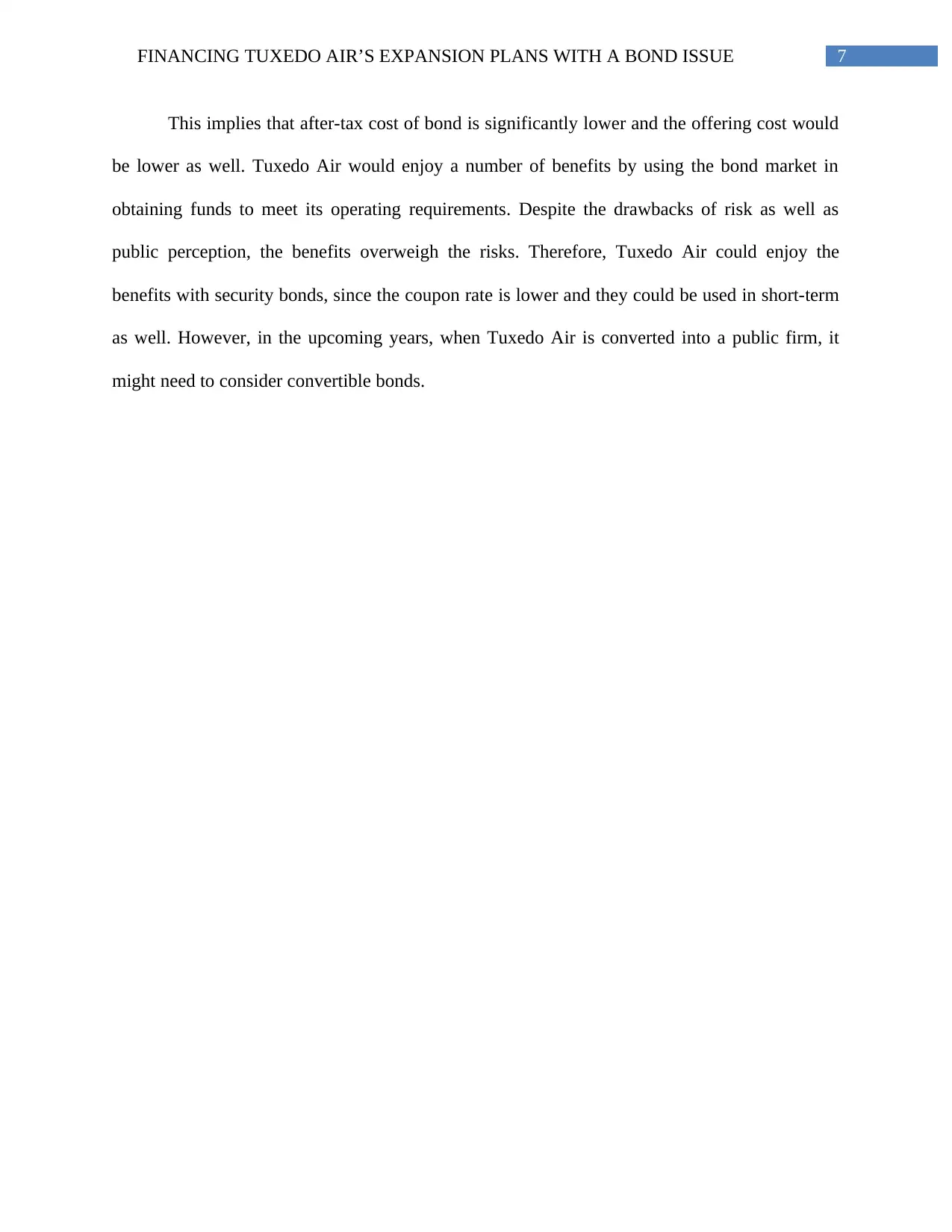
7FINANCING TUXEDO AIR’S EXPANSION PLANS WITH A BOND ISSUE
This implies that after-tax cost of bond is significantly lower and the offering cost would
be lower as well. Tuxedo Air would enjoy a number of benefits by using the bond market in
obtaining funds to meet its operating requirements. Despite the drawbacks of risk as well as
public perception, the benefits overweigh the risks. Therefore, Tuxedo Air could enjoy the
benefits with security bonds, since the coupon rate is lower and they could be used in short-term
as well. However, in the upcoming years, when Tuxedo Air is converted into a public firm, it
might need to consider convertible bonds.
This implies that after-tax cost of bond is significantly lower and the offering cost would
be lower as well. Tuxedo Air would enjoy a number of benefits by using the bond market in
obtaining funds to meet its operating requirements. Despite the drawbacks of risk as well as
public perception, the benefits overweigh the risks. Therefore, Tuxedo Air could enjoy the
benefits with security bonds, since the coupon rate is lower and they could be used in short-term
as well. However, in the upcoming years, when Tuxedo Air is converted into a public firm, it
might need to consider convertible bonds.
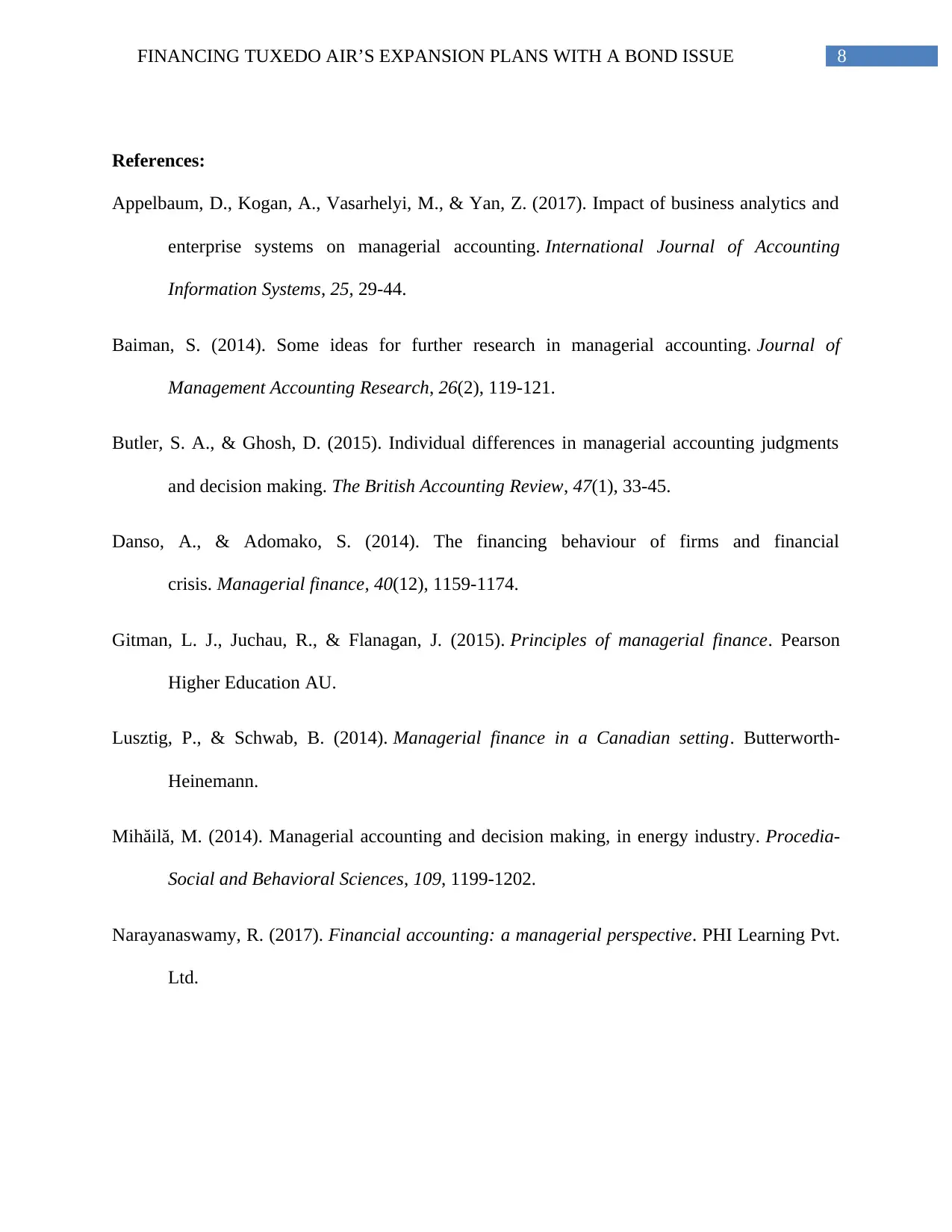
8FINANCING TUXEDO AIR’S EXPANSION PLANS WITH A BOND ISSUE
References:
Appelbaum, D., Kogan, A., Vasarhelyi, M., & Yan, Z. (2017). Impact of business analytics and
enterprise systems on managerial accounting. International Journal of Accounting
Information Systems, 25, 29-44.
Baiman, S. (2014). Some ideas for further research in managerial accounting. Journal of
Management Accounting Research, 26(2), 119-121.
Butler, S. A., & Ghosh, D. (2015). Individual differences in managerial accounting judgments
and decision making. The British Accounting Review, 47(1), 33-45.
Danso, A., & Adomako, S. (2014). The financing behaviour of firms and financial
crisis. Managerial finance, 40(12), 1159-1174.
Gitman, L. J., Juchau, R., & Flanagan, J. (2015). Principles of managerial finance. Pearson
Higher Education AU.
Lusztig, P., & Schwab, B. (2014). Managerial finance in a Canadian setting. Butterworth-
Heinemann.
Mihăilă, M. (2014). Managerial accounting and decision making, in energy industry. Procedia-
Social and Behavioral Sciences, 109, 1199-1202.
Narayanaswamy, R. (2017). Financial accounting: a managerial perspective. PHI Learning Pvt.
Ltd.
References:
Appelbaum, D., Kogan, A., Vasarhelyi, M., & Yan, Z. (2017). Impact of business analytics and
enterprise systems on managerial accounting. International Journal of Accounting
Information Systems, 25, 29-44.
Baiman, S. (2014). Some ideas for further research in managerial accounting. Journal of
Management Accounting Research, 26(2), 119-121.
Butler, S. A., & Ghosh, D. (2015). Individual differences in managerial accounting judgments
and decision making. The British Accounting Review, 47(1), 33-45.
Danso, A., & Adomako, S. (2014). The financing behaviour of firms and financial
crisis. Managerial finance, 40(12), 1159-1174.
Gitman, L. J., Juchau, R., & Flanagan, J. (2015). Principles of managerial finance. Pearson
Higher Education AU.
Lusztig, P., & Schwab, B. (2014). Managerial finance in a Canadian setting. Butterworth-
Heinemann.
Mihăilă, M. (2014). Managerial accounting and decision making, in energy industry. Procedia-
Social and Behavioral Sciences, 109, 1199-1202.
Narayanaswamy, R. (2017). Financial accounting: a managerial perspective. PHI Learning Pvt.
Ltd.
⊘ This is a preview!⊘
Do you want full access?
Subscribe today to unlock all pages.

Trusted by 1+ million students worldwide
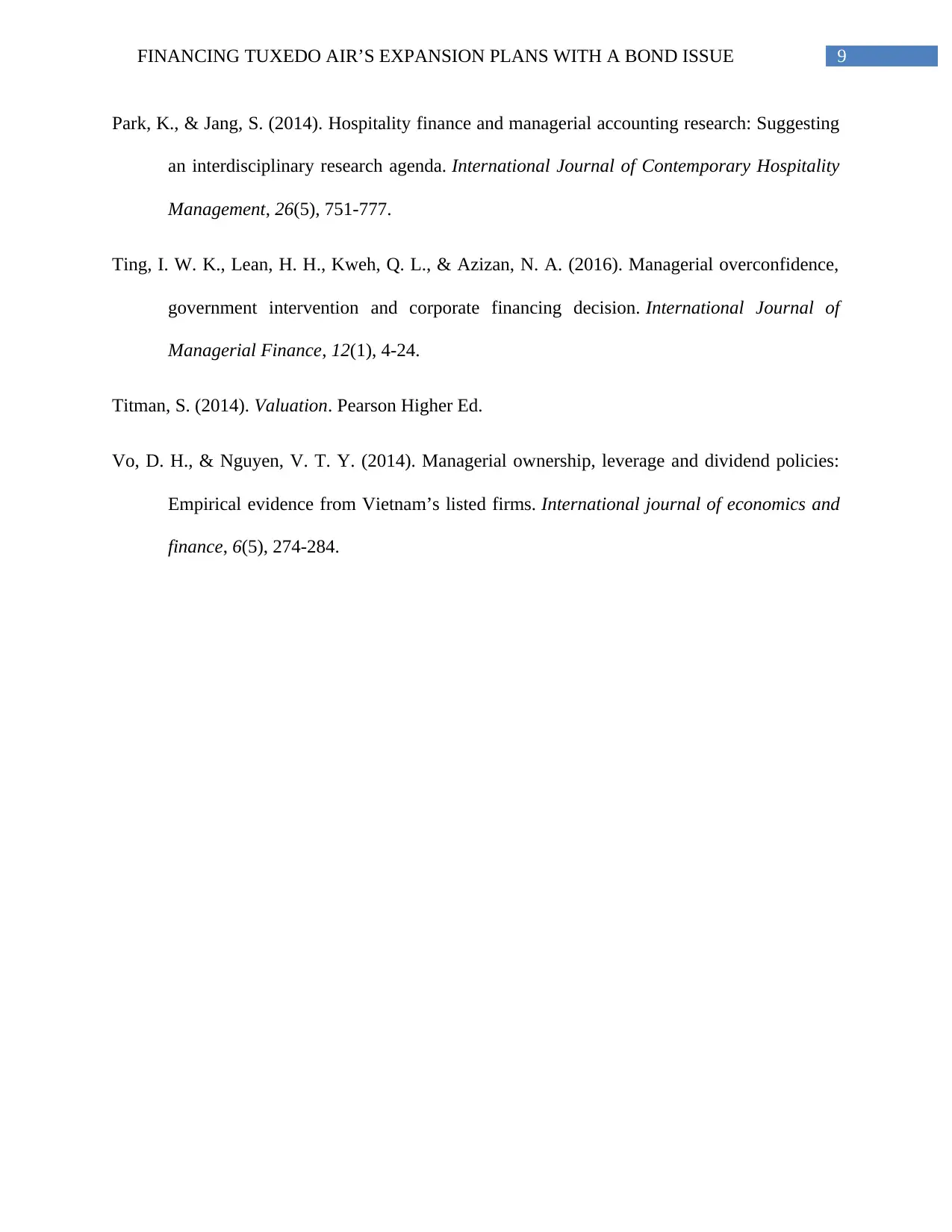
9FINANCING TUXEDO AIR’S EXPANSION PLANS WITH A BOND ISSUE
Park, K., & Jang, S. (2014). Hospitality finance and managerial accounting research: Suggesting
an interdisciplinary research agenda. International Journal of Contemporary Hospitality
Management, 26(5), 751-777.
Ting, I. W. K., Lean, H. H., Kweh, Q. L., & Azizan, N. A. (2016). Managerial overconfidence,
government intervention and corporate financing decision. International Journal of
Managerial Finance, 12(1), 4-24.
Titman, S. (2014). Valuation. Pearson Higher Ed.
Vo, D. H., & Nguyen, V. T. Y. (2014). Managerial ownership, leverage and dividend policies:
Empirical evidence from Vietnam’s listed firms. International journal of economics and
finance, 6(5), 274-284.
Park, K., & Jang, S. (2014). Hospitality finance and managerial accounting research: Suggesting
an interdisciplinary research agenda. International Journal of Contemporary Hospitality
Management, 26(5), 751-777.
Ting, I. W. K., Lean, H. H., Kweh, Q. L., & Azizan, N. A. (2016). Managerial overconfidence,
government intervention and corporate financing decision. International Journal of
Managerial Finance, 12(1), 4-24.
Titman, S. (2014). Valuation. Pearson Higher Ed.
Vo, D. H., & Nguyen, V. T. Y. (2014). Managerial ownership, leverage and dividend policies:
Empirical evidence from Vietnam’s listed firms. International journal of economics and
finance, 6(5), 274-284.
1 out of 10
Your All-in-One AI-Powered Toolkit for Academic Success.
+13062052269
info@desklib.com
Available 24*7 on WhatsApp / Email
![[object Object]](/_next/static/media/star-bottom.7253800d.svg)
Unlock your academic potential
Copyright © 2020–2025 A2Z Services. All Rights Reserved. Developed and managed by ZUCOL.
